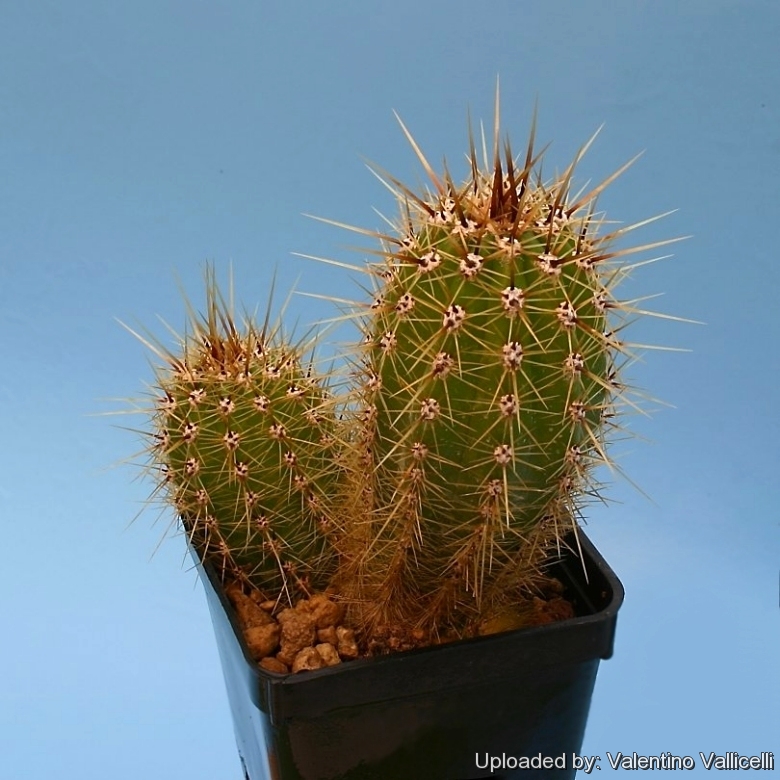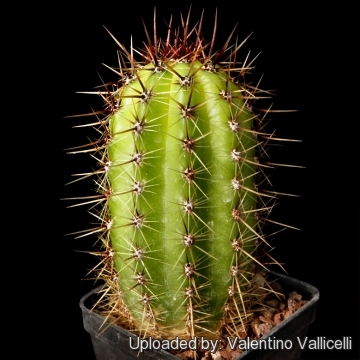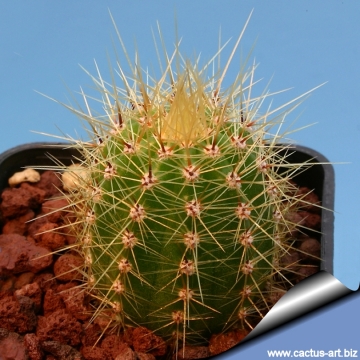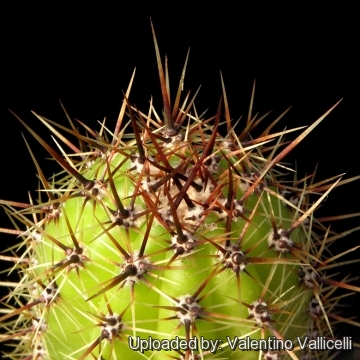Accepted Scientific Name: Echinopsis lamprochlora (Lem.) F.A.C.Weber ex Friedrich & Glaetzle
Bradleya 1: 96. 1983

Echinopsis purpureopilosa Photo by: Valentino Vallicelli
Origin and Habitat: Sierra de Cordoba, Argentina.
Habitat: It found on grass-covered hills with rock inclusions and rocky slopes at medium elevation on the Andean Cordillera.
Synonyms:
See all synonyms of Echinopsis lamprochlora
back
Accepted name in llifle Database:Echinopsis lamprochlora (Lem.) F.A.C.Weber ex Friedrich & GlaetzleBradleya 1: 96. 1983Synonymy: 6
back
Description: Echinopsis purpureopilosaSN|8214]]SN|8217]] (Trichocereus purpureopilosusSN|8218]]SN|8218]]) is probably one of the many geographical forms of the variable Echinopsis lamprochloraSN|8217]]SN|8214]]. It is a strong growing shrubby cactus with lovely shining bright green columnar stems.
Habit: Colony forming with branches from below, stems erect or semi-prostrate and ascending.
Stem: Cylindrical, 30-50 (or more) cm tall, glossy grass green, 6 to 8 cm. thick.
Ribs: about 12 (bat varying from 9 to 15), low, rounded, slightly notched below the areoles, which are to 1 to 1,2 cm apart.
Spines: Stiff, sharp, light horn coloured, carmine and thickened below.
Central spines: 4(-5), forming a cross, lower one stronger often curving downward, 27-30 mm long.
Radial spines: 10-20, shorter 6-9 mm long.
Flowers: Funnel-shaped, very large, white with a pink sheen, 20-24 cm long.
Bibliography: Major references and further lectures
1) Edward Anderson “The Cactus family” Timber Press, Incorporated, 2001
2) James Cullen, Sabina G. Knees, H. Suzanne Cubey "The European Garden Flora Flowering Plants: A Manual for the Identification of Plants Cultivated in Europe, Both Out-of-Doors and Under Glass" Cambridge University Press, 11/Aug/2011
3) David R Hunt; Nigel P Taylor; Graham Charles; International Cactaceae Systematics Group. "The New Cactus Lexicon" dh books, 2006
4) N. L. Britton, J. N. Rose “The Cactaceae. Descriptions and Illustrations of Plants of the Cactus Family.” Volume 4, The Carnegie Institution of Washington, Washington 1923
5) Curt Backeberg “Die Cactaceae: Handbuch der Kakteenkunde” Gustav Fischer Verlag, Stuttgart New York 1982–1985
6) John Borg “Cacti: a gardener's handbook for their identification and cultivation” Blandford P., 1970
 Echinopsis purpureopilosa Photo by: Valentino Vallicelli
Echinopsis purpureopilosa Photo by: Valentino Vallicelli Echinopsis purpureopilosa Photo by: Cactus Art
Echinopsis purpureopilosa Photo by: Cactus Art Echinopsis purpureopilosa Photo by: Valentino Vallicelli
Echinopsis purpureopilosa Photo by: Valentino VallicelliSend a photo of this plant.The gallery now contains thousands of pictures, however it is possible to do even more. We are, of course, seeking photos of species not yet shown in the gallery but not only that, we are also looking for better pictures than those already present.
Read More... Cultivation and Propagation: Echinopsis lamprochlora is a cold hardy barrel cacti, that can tolerates in winter both, ice, snow, hail, and rain and temperatures down to –7 to -12° C (depending on clones)
Growth rate: It is a relatively rapidly growing species that will make clumps given the best conditions.
Soils: It likes very porous standard cactus mix soil. Prefer a low pH compost, avoid substrata rich in limestone; otherwise growth will stop altogether.
Repotting: This plant needs plenty of space for its roots, repotting should be done every other year or when the it has outgrown its pot. Use pot with good drainage.
Watering: Needs moderate to copious waterings in summer, but do not overwater (Rot prone), keep dry in winter at a minimum temperature of 0°C.
Fertilization: Feed with a high potassium fertilizer in summer.
Hardiness: Reputedly resistant to frost if kept on the dry side prior to, and during, cold weather (hardy to -7 C ° C, or less for short periods). Zone (8b-)9 to 10
Exposition: The plant tolerates extremely bright situations which encourages flowering and heavy spine production, but is likely to suffer from sun scorch or stunted growth if over exposed to direct sunlight during the hottest part of the day in summer. It may tolerate filtered sunlight or afternoon shade.
Uses: It is an excellent plant for container growing. It always looks good and stays small. It look fine in a cold greenhouse and frame or outdoor in a rockery.
Pests & diseases: It may be attractive to a variety of insects, but plants in good condition should be nearly pest-free, particularly if they are grown in a mineral potting-mix, with good exposure and ventilation. Nonetheless, there are several pests to watch for:
- Red spiders: Red spiders may be effectively rubbed up by watering the plants from above.
- Mealy bugs: Mealy bugs occasionally develop aerial into the new growth among the wool with disfiguring results, but the worst types develop underground on the roots and are invisible except by their effects.
- Scales: Scales are rarely a problem.
- Rot: This species is particularly easy and accommodating, seldom suffer of cryptogamic diseases. Rot it is only a minor problem with Echinopsis if the plants are watered and “aired” correctly. If they are not, fungicides won't help all that much.
Propagation: Division of larger clumps, direct sow after last frost. Seeds germinate in 7-14 days at 21-27° C in spring, remove gradually the glass cover as soon the plants will be well rooted (ca 1-2 weeks) and keep ventilated, no full sun for young plants! To make a cutting twist off a branch and permit it to dry out a couple of weeks, lay it on the soil and insert the stem end partially into the soil. Try to keep the cutting somewhat upright so that the roots are able to grow downward














